Retrospective of Civilization Board Games (Part Two)
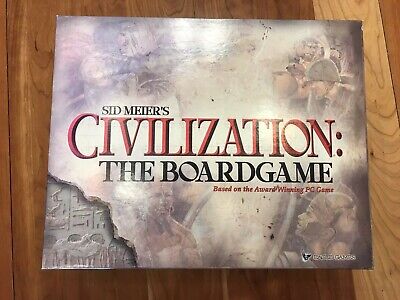 — Create a civilization to stand the test of time!
— Create a civilization to stand the test of time!
By Patrick S. Baker
Moves: Legal and Business
In 1996, MicroProse released Sid Meier’s Civilization II (Civ II) for the personal computer (PC) and Avalon Hill then sued MicroProse over the use of the name, Civilization, asserting they had reclaimed the previously licensed copyright. As this lawsuit worked through the legal system, Activision released Civilization: Call to Power, also for the PC, in 1998. This set off a three-sided legal battle over the use of the name. At the same time “the video game industry … was like the Wild West, with companies starting up, closing, buying and selling other companies, and also trading, assigning and purchasing Intellectual Properties (IPs) at a furious rate.”
By the time the legal wrangling and business acquisitions were settled, gaming giant Hasbro owned both MicroProse and Avalon Hill. Further, the copyright for the name Civilization for any type of game was owned by MicroProse. Activision could continue to sell their game, but had to pay royalties to MicroProse. In 2001, MicroProse went out of business for good and Hasbro sold all the MicroProse’s IPs to the French company gaming company, Infogrames.
Sid Meier’s Civilization: The Board Game (2002)
The first Sid Meier’s Civilization: The Boardgame was released in 2002, while Infogrames still owned the IP. The game was created by Glenn Drover and published by Eagle Games. The game was based largely on Sid Meier’s Civilization III (2001). Drover had been a sales manager at MicroProse during the development of the original PC game, Sid Meier’s Civilization, but he had not been directly involved in its creation.
The board-game was designed for between two and six players, with each player controlling one of six great civilizations. The game was played on a stylized map of the Earth. The players started with a small settlement, a settler and a swordsman unit. These are placed on a region of the players choosing. When playing using the advanced rules, the player also begins with one technology.
There were two sets of rules: the less complex “standard rules” and the more complex “advanced” set. The advanced rules used more elements from the Civilization III video game, than did the standard rules.
Each turn consists of four segments:
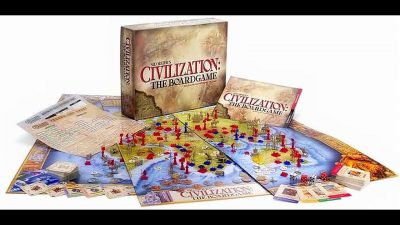
Movement: Players could move any or all of the units on the board.
Trade: Players conducted trades.
Production: Each player generated gold.
Purchase: Players could purchase units, build, or upgrade settlements, and discover new technologies.
The game’s time line was divided into four eras: Ancient, Medieval, Industrial, and Modern. In the standard rules, the eras progressed at the end of a turn in which all technologies of the current era were researched, or in which one player discovered three technologies from the current era. In the advanced rules, the era progressed when the first technology from the next era was researched.
The game ended when only one player had surviving settlements and that player was the winner. Or, in the standard rules, when one player discovered three technologies from the Modern era. Or, in the advanced rules, when a player constructed a particular Wonder of the World, which allowed that player declare the game over at any point after that. In the last two cases, players were awarded victory points for their settlements, technologies, and wonders and the player with the greatest number of victory points won the game
Sid Meier’s Civilization: The Boardgame (2002) received good reviews. The reviewers called it “excellent”, “complex” and “engaging”, but also stating that it took a long, long time (perhaps too long) to play. The game won the “2002 Origins Awards for Best Historical Board Game”. But it has a meta-score of only 5.6 out of 10 for customer reviews on Boardgamegeek .com. The game is currently out of print.
A Business Interlude and the Card Game
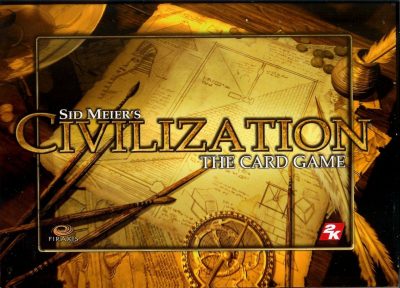 In 2004, Infogrames sold the Civilization IP to Take-Two Interactive. That same year Take-Two bought Sid Meier’s new company, Firaxis, the developer of the Civilization video game series. Take-Two then assigned the IP for the Civilization video games to Firaxis. Take-Two would go on to license board and card games bearing the Civilization name to other companies.
In 2004, Infogrames sold the Civilization IP to Take-Two Interactive. That same year Take-Two bought Sid Meier’s new company, Firaxis, the developer of the Civilization video game series. Take-Two then assigned the IP for the Civilization video games to Firaxis. Take-Two would go on to license board and card games bearing the Civilization name to other companies.
Civilization: The Card Game was a card game designed by Soren Johnson, Civilization IV’s (Civ IV) lead designer, and was based on Civ IV. It was published by Firaxis Games in 2006 and included as a bonus in the Sid Meier’s Civilization Chronicles boxed set. This was a boxed collection of every PC game of Civilization series up to that point. The card game was not sold separately.
The card game replicates the rise of civilizations, just like the video game series does. Players gain territory, collect resources, construct buildings, build Wonders of the World, research new technologies, and battle each other on their way to victory.
There are three types of cards in the game:
Plot Cards which are the basis for the game’s economy.
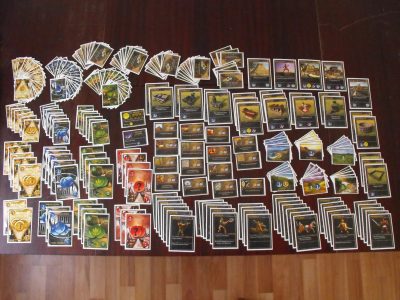 Resource Cards which are used to purchase items in the game.
Resource Cards which are used to purchase items in the game.
And Population Cards which represent the population of a player’s faction.
The game ends when the last technology is discovered with winner being the player with the most Victory Points. Victory Points are determined through Wonders, Technologies, and Population. In the event of a tie, the number of technologies, then the population points, and last the number of Wonders, are considered to break the tie.
Sid Meier’s Civilization: The Board Game (2010)
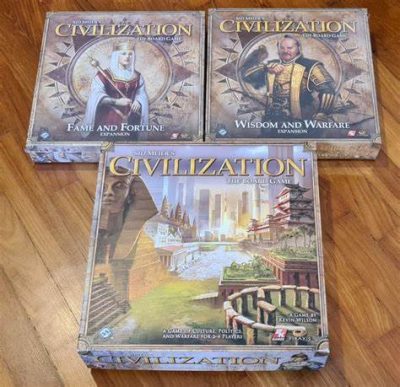 This version of Sid Meier’s Civilization: The Board Game (2010) game was designed by Kevin Wilson and published by Fantasy Flight Games in 2010 and is based on Civilization IV (2005). This 2010 game was not a direct sequel to the 2002 game, despite the exact same name.
This version of Sid Meier’s Civilization: The Board Game (2010) game was designed by Kevin Wilson and published by Fantasy Flight Games in 2010 and is based on Civilization IV (2005). This 2010 game was not a direct sequel to the 2002 game, despite the exact same name.
This version of Civilization: The Board Game, was for between two and four players, with each player taking one of six different civilizations: America, China, Egypt, Germany, Rome, or Russia. Each civilization has a unique starting map position, a specific national capability and one starting technology.
The map consists of a number of modular map tiles, which, except for each civilization’s unique starting map tile, are placed face-down. At the start of the game, each player has a capital city in the center of their own map tile, a military unit and a scouting unit which are adjacent to the civilization’s capital. The map tiles are turned face up as players’ units explore the world.
Each turn has five phases:
Start Phase: Players may build cities, change governments, and perform start-of-turn maintenance. Players may have up to three cities. Cities are founded by scout units and are subject to certain restrictions.
Trade Phase: Players collects trade that was generated by their cities and mayalso negotiate on trade deals between each other during this phase.
City Management Phase, each player may take an action for each of their cities. Each city may either produce a unit or building, increase culture points, or collect resources.
Movement Phase: Players move units, explore tiles, capture huts and villages, and attack enemies.
Research Phase: Players spend their trade to research technologies and advance their civilizations.
The game can be won in any of four ways. A Military Victory is achieved by conquering one other player’s capital. A Science Victory is achieved by discovering Space Flight which is the only Level Five technology in the game. An Economic Victory is won by gaining fifteen coins. A Cultural Victory is won by the player being the first to reach the end of the culture track.
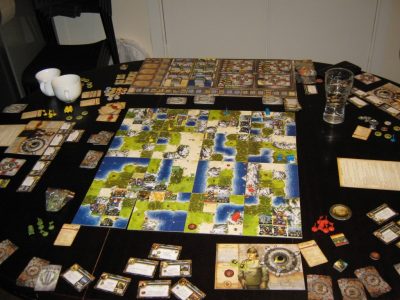 The game was well received with an aggregated 7.8 out of 10 on Boardgamegeek.com. It was also the 2011 JoTa Best Heavy Board Game Audience Award winner. Further, it was nominated for three Golden Geek Awards and a Tric Trac Award.
The game was well received with an aggregated 7.8 out of 10 on Boardgamegeek.com. It was also the 2011 JoTa Best Heavy Board Game Audience Award winner. Further, it was nominated for three Golden Geek Awards and a Tric Trac Award.
Two expansion packs were released for the game and were largely based on Civilization V.
In November 2011, the first expansion pack for the game was released, titled Fame and Fortune. Fame and Fortune added four new civilizations to the game: Arabs, Greeks, Indians and the Spanish. Several new optional game mechanics were introduced to the game, new map tiles and the expansion included enough parts to add a fifth player.
Wisdom and Warfare was the next expansion pack and was released in August 2013. It added six new civilizations to the game: Aztecs, English, French, Japanese, Mongols and Zulu. New rules options were added as well adding depth and complexity to the games.
Civilization: A New Dawn (2017)
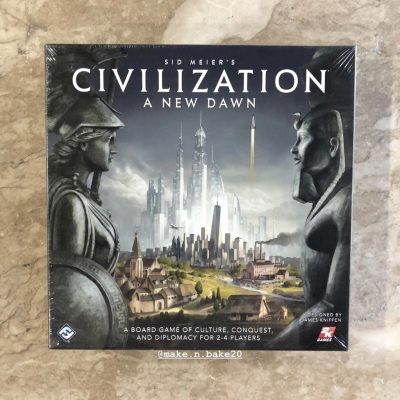
Civilization: A New Dawn was released in 2017 also by Fantasy Flight Games, and was the third boardgame based on the Sid Meier’s video game series. It was not a direct sequel to either of the two previous boardgames.
A New Dawn was designed for two to four players and unlike the first two games, which could take between four to eight hours to play, the one could be completed in one or two hours. The game started with players randomly choosing one the leader sheets of one of eight civilizations and all the components associated with that civilization. Players then constructed the map on which the game was to be played. The map construction started by selecting four random tiles to form the civilization’s central core. Two of these tiles must had have a natural wonder and the other two must each have a city-state. Each player then drew a hand of three map tiles and one starting tile with their capital city.
The game play in A New Dawn was simple, with a card draw used to take an action and complete a turn. Otherwise, the strategy and victory conditions were very similar to its predecessors. Players expanded their influence to establish new cities, gather resources to build wonders, made technological advancements and built their military strength. The first player to meet the victory conditions in either the military, science, economy, industry, or culture fields won the game.
In 2020 an expansion pack titled Terra Incognita was published. The expansion pack added ten more civilizations to the game and now a fifth player could be added. The expansion pack also added some new rules, such as new kinds of governments, new combat rules and rules for expanding a civilization’s cities.
The game has a 7.3 out of 10 on Boardgamegeek.com. Reviews of the game are split about the games level of depth and complexity. One review praised the “speed and scale” of the play. Another said that the game was “a fresh and thoughtful take on the world-conquering genre,” while staying “intensely competitive”. The same reviewer applauded the “streamlined card play that made sure “turns stay quick and simple.” Still, the reviewer also said that the boardgame was not much like the video games.
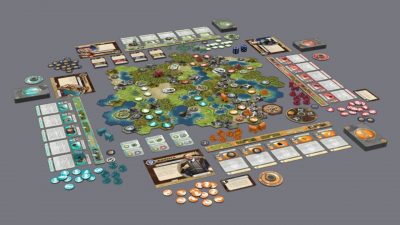 Other reviewers thought the game mechanics had become “too streamlined” and that it was so simplified that the game was good for beginners, but experienced Civilization (or other 4X games) players would not get much out it. Another reviewer said “everything you know and love about Civ—war, diplomacy, trade, exploration, settlement—has been stripped to the bone, to the point where little of it is actually any fun.”
Other reviewers thought the game mechanics had become “too streamlined” and that it was so simplified that the game was good for beginners, but experienced Civilization (or other 4X games) players would not get much out it. Another reviewer said “everything you know and love about Civ—war, diplomacy, trade, exploration, settlement—has been stripped to the bone, to the point where little of it is actually any fun.”
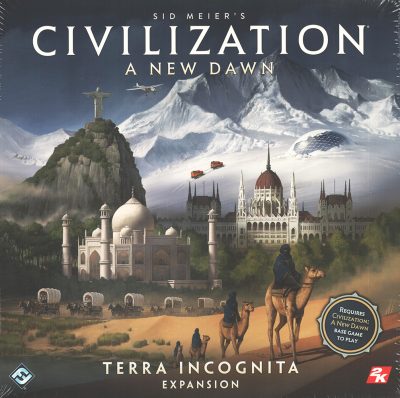
Still, A New Dawn was nominated for the 2017 Board Game Quest Awards Game of the Year and Board Game Quest Awards Best Strategy/Euro Game.
We have now come full circle. When PC games were first starting, many of the best video games were inspired by, or direct sequels, or ports, of successful board games. For example, Advance Squad Leader inspired the Close Combat series, Kingmaker was directly ported to the PC, and so on. Now, video games like the Fallout series, Doom, and the Civilization series are inspiring award-winning board games.
Sources:
2002 Origin Awards, the (2003) Best Historical Board Game
Academic Gaming Review (30 Mar 2003) The Fall of Avalon Hill
Boardgamegeek.com. Civilization: A New Dawn
_______ Sid Meier’s Civilization: The Boardgame (2002)
_______ Sid Meier’s Civilization: The Card Game
_______ Sid Meier’s Civilization: The Boardgame (2010)
Boardgamereviewsbyjosh.com Civilization: The Board Game (2010 Fantasy Flight Games) Review
Boardgaemquest.com (12 Dec. 2017) Sid Meier’s Civilization: A New Dawn Review
Boardgamewizard.com Sid Meier’s Civilization Board Game (2010 edition) Review, Rules & Instructions
Firaxis.com Sid Meier’s Civilization Chronicles
Gamespot.com (26 Jan. 2005) Take-Two takes over Civilization
Guardian, The (2 Feb 2018). “Civilization: A New Dawn brings the empire-building video game to your dinner table”.
Kotaku.com (4 Jan. 2018) Civilization: A New Dawn: The Kotaku Review
No Dice, No Glory (3 Sep 2021) X-COM Franchise Retrospective (Part Four)
Paste (8 may 2018) The Civilization: A New Dawn Board Game Might Be Too Streamlined
Pyramid (20 Dec 2002) Pyramid Review: Sid Meier’s Civilization: The Boardgame.
RPG.net (13 July 2005) Review of Sid Meier’s Civilization: The Boardgame
